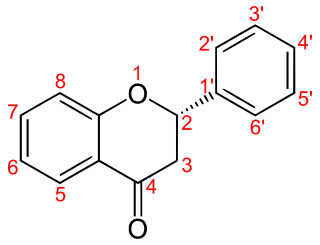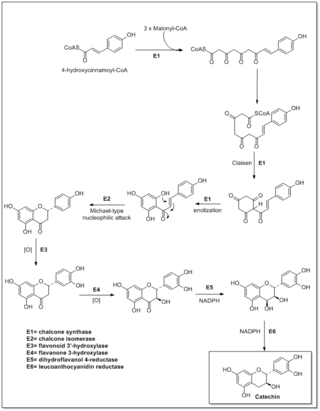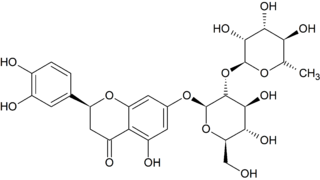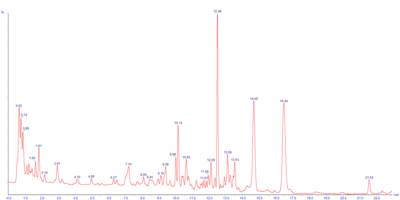
Naringenin is a flavanone from the flavonoid group of polyphenols and is commonly found in a variety of citrus fruits and is the predominant flavonone in grapefruit. Naringenin has demonstrated numerous biological activities, including anti-inflammatory properties, antioxidant activity and skin healing. It is used as a cosmetic ingredient and dietary supplement. Naringenin is thought to be responsible for CYP3A4 suppression in the intestinal wall, that may result in serious changes of pharmacokinetics in drugs related with this enzyme.

Naringin is a flavanone-7-O-glycoside between the flavanone naringenin and the disaccharide neohesperidose. The flavonoid naringin occurs naturally in citrus fruits, especially in grapefruit, where naringin is responsible for the fruit's bitter taste. In commercial grapefruit juice production, the enzyme naringinase can be used to remove the bitterness (debittering) created by naringin. In humans naringin is metabolized to the aglycone naringenin by naringinase present in the gut.

Hesperidin is a flavanone glycoside found in citrus fruits. Its aglycone is hesperetin. Its name is derived from the word "hesperidium", for fruit produced by citrus trees.

Hesperetin is the 4'-methoxy derivative of eriodictyol, a flavanone. Hesperetin's 7-O-glycoside, hesperidin, is a naturally occurring flavanon-glycoside, the main flavonoid in lemons and sweet oranges. Hesperetin are not found to a significant extent in Citrus spp.
Naringinase is a debittering enzyme that is used in the commercial production of citrus juices. It breaks down the compound naringin that gives citrus juices its bitter taste. It is a multienzyme complex which possesses alpha-L-rhamnosidase and beta glucosidase active centers. The E.C. No.(EC 3.2.1.40) of the naringinase and rhamnosidase are the same. First rhamnosidase breaks naringin into prunin and rhamnose. Lastly glucosidase breaks prunin into glucose and naringenin, a flavorless flavanone also found in various citrus.

The flavanones, a type of flavonoids, are various aromatic, colorless ketones derived from flavone that often occur in plants as glycosides.
In enzymology, a flavanone 3-dioxygenase (EC 1.14.11.9) is an enzyme that catalyzes the chemical reaction

Flavonoids are synthesized by the phenylpropanoid metabolic pathway in which the amino acid phenylalanine is used to produce 4-coumaroyl-CoA. This can be combined with malonyl-CoA to yield the true backbone of flavonoids, a group of compounds called chalcones, which contain two phenyl rings. Conjugate ring-closure of chalcones results in the familiar form of flavonoids, the three-ringed structure of a flavone. The metabolic pathway continues through a series of enzymatic modifications to yield flavanones → dihydroflavonols → anthocyanins. Along this pathway, many products can be formed, including the flavonols, flavan-3-ols, proanthocyanidins (tannins) and a host of other various polyphenolics.
In enzymology, a flavanone 7-O-beta-glucosyltransferase is an enzyme that catalyzes the chemical reaction
In enzymology, a flavanone 7-O-glucoside 2"-O-beta-L-rhamnosyltransferase is an enzyme that catalyzes the chemical reaction

Tricin is a chemical compound. It is an O-methylated flavone, a type of flavonoid. It can be found in rice bran and sugarcane.

Isosakuranetin, an O-methylated flavonoid, is the 4'-methoxy derivative of naringenin, a flavanone. Didymin, a disaccharide of isosakuranetin, occur e.g. in sweet orange, blood orange and mandarin. Isosakuranetin is a potent inhibitor of TRPM3 channels.

Sakuranetin is a flavan-on, the 7-methoxy derivative of naringenin, found in Polymnia fruticosa and rice, where it acts as a phytoalexin against spore germination of Pyricularia oryzae.

Dihydrochalcone (DHC) is the organic compound with the formula C6H5C(O)(CH2)2C6H5. It is the reduced derivative of chalcone (C6H5C(O)(CH)2C6H5). It is white solid that is soluble in many organic solvents. Dihydrochalcone per se is often minor significance, but some derivatives occur in nature and have attracted attention as drugs.

The flavan-4-ols (3-deoxyflavonoids) are flavone-derived alcohols and a family of flavonoids. Flavan-4-ols are colorless precursor compounds that polymerize to form red phlobaphene pigments. They can be found in the sorghum. Glycosides can be isolated from a methanol extract of the rhizomes of Abacopteris penangiana.
C-methylated flavonoids are a category of flavonoid having methylation(s) on carbon. An example of such compounds is the flavanone poriol.

Retusin is an O-methylated flavonol, a type of flavonoid. It can be found in Origanum vulgare and in Ariocarpus retusus.

Neoeriocitrin is a 7-O-glycoside of the flavanone eriodictyol and the disaccharide neohesperidose . Note that the 'neo' in the name in this case does not refer to the position of the B-ring, but refer to the glycosyl moiety.

Neohesperidin is a flavanone glycoside found in citrus fruits. It is the 7-O-neohesperidose derivative of hesperetin, which in turn is the 4'-methoxy derivative of eriodictyol. Neohesperidin dihydrochalcone has an intense sweet taste, and is listed as a Generally Recognized as Safe flavour enhancer by the Flavour and Extract Manufacturers' Association.

Prunin is a flavanone glycoside found in immature citrus fruits and in tomatoes. Its aglycone form is called naringenin.
















